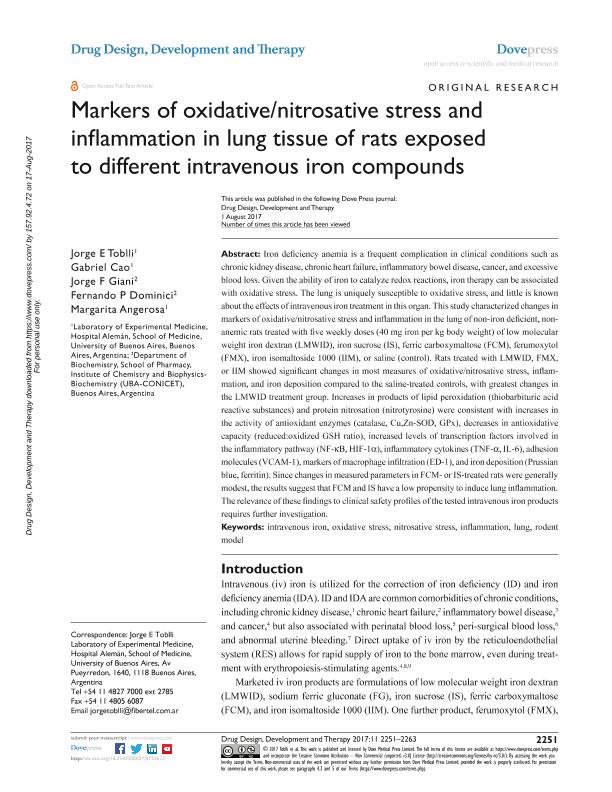Artículo
Markers of oxidative/nitrosative stress and inflammation in lung tissue of rats exposed to different intravenous iron compounds
Toblli, Jorge Eduardo ; Cao, Gabriel Fernando
; Cao, Gabriel Fernando ; Giani, Jorge Fernando
; Giani, Jorge Fernando ; Dominici, Fernando Pablo
; Dominici, Fernando Pablo ; Angerosa, Margarita
; Angerosa, Margarita
 ; Cao, Gabriel Fernando
; Cao, Gabriel Fernando ; Giani, Jorge Fernando
; Giani, Jorge Fernando ; Dominici, Fernando Pablo
; Dominici, Fernando Pablo ; Angerosa, Margarita
; Angerosa, Margarita
Fecha de publicación:
08/2017
Editorial:
Dove Press
Revista:
Drug Design, Development and Therapy
ISSN:
1177-8881
Idioma:
Inglés
Tipo de recurso:
Artículo publicado
Clasificación temática:
Resumen
Iron deficiency anemia is a frequent complication in clinical conditions such as chronic kidney disease, chronic heart failure, inflammatory bowel disease, cancer, and excessive blood loss. Given the ability of iron to catalyze redox reactions, iron therapy can be associated with oxidative stress. The lung is uniquely susceptible to oxidative stress, and little is known about the effects of intravenous iron treatment in this organ. This study characterized changes in markers of oxidative/nitrosative stress and inflammation in the lung of non-iron deficient, non-anemic rats treated with five weekly doses (40 mg iron per kg body weight) of low molecular weight iron dextran (LMWID), iron sucrose (IS), ferric carboxymaltose (FCM), ferumoxytol (FMX), iron isomaltoside 1000 (IIM), or saline (control). Rats treated with LMWID, FMX, or IIM showed significant changes in most measures of oxidative/nitrosative stress, inflammation, and iron deposition compared to the saline-treated controls, with greatest changes in the LMWID treatment group. Increases in products of lipid peroxidation (thiobarbituric acid reactive substances) and protein nitrosation (nitrotyrosine) were consistent with increases in the activity of antioxidant enzymes (catalase, Cu,Zn-SOD, GPx), decreases in antioxidative capacity (reduced:oxidized GSH ratio), increased levels of transcription factors involved in the inflammatory pathway (NF-κB, HIF-1α), inflammatory cytokines (TNF-α, IL-6), adhesion molecules (VCAM-1), markers of macrophage infiltration (ED-1), and iron deposition (Prussian blue, ferritin). Since changes in measured parameters in FCM- or IS-treated rats were generally modest, the results suggest that FCM and IS have a low propensity to induce lung inflammation. The relevance of these findings to clinical safety profiles of the tested intravenous iron products requires further investigation.
Archivos asociados
Licencia
Identificadores
Colecciones
Articulos(IQUIFIB)
Articulos de INST.DE QUIMICA Y FISICO-QUIMICA BIOLOGICAS "PROF. ALEJANDRO C. PALADINI"
Articulos de INST.DE QUIMICA Y FISICO-QUIMICA BIOLOGICAS "PROF. ALEJANDRO C. PALADINI"
Citación
Toblli, Jorge Eduardo; Cao, Gabriel Fernando; Giani, Jorge Fernando; Dominici, Fernando Pablo; Angerosa, Margarita; Markers of oxidative/nitrosative stress and inflammation in lung tissue of rats exposed to different intravenous iron compounds; Dove Press; Drug Design, Development and Therapy; 11; 8-2017; 2251-2263
Compartir
Altmétricas



